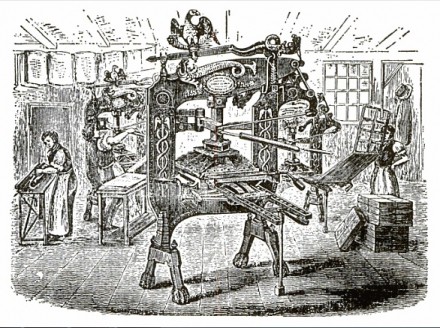Celebrate George Clymer and the Columbian hand press in 2017
A guest post from Robert Oldham on the opportunities presented by the two-hundredth anniversary of the production of the first Columbian hand presses in the UK in 1817. (Ad Lib Press, Turrialba, Costa Rica)
George Clymer, of Philadelphia USA, invented the Columbian hand press in 1813, and tried for four years to sell enough of them for a successful business; however, the press was considerably more expensive than the then-predominant wooden Common press. He was not satisfied with the sales results (he may have only sold about 25 presses in four years), and in 1817 took his design to England to try that market.
Clymer arrived in London in the late summer of 1817 and immediately obtained a patent and began making arrangements to produce some presses. Although he supposedly engaged Richard Cope, a London engineer, to help him, by whatever means, Clymer produced and began selling Columbian presses in the Fall of 1817.
1817 was thus an important milestone in the development of the iron hand press and specifically of the Columbian hand press, and 2017 provides an opportunity to celebrate this important contribution to printing technology and the resulting growth of the industry.
Clymer made a great success of the Columbian, with a combination of a sound and powerful press design and a strong and effective marketing strategy. By the end of 1818 he had probably exceeded his total sales in the US, and the volume continued to grow. By the end of 1820 he had been in production just over three years and had produced, and probably sold, double the number of presses made in the USA in four years (press number 57 was built in 1820).
In Europe, Clymer’s marketing strategy included giving Columbians to influential monarchs on the European Continent — specifically one to King William I of The Netherlands, the mechanical principles of which were copied by a press builder at the direction of the Printer to His Majesty. Another was given to Tsar Alexander of Russia, who awarded Clymer 6000 rubles for his invention.
In addition, a Columbian was purchased in 1823 by Eduard Vieweg, son of the publisher Friedrich Vieweg of Braunschweig, Germany, for the Vieweg pressroom, and the next year Vieweg arranged for the iron foundry at Zorge to make a number of copies of the press. Not long after that he obtained a license from Clymer to make and sell the Columbian in Germany.
The Columbian press outlived George Clymer by more than 70 years – Columbians were still being produced and sold, in limited numbers, in the early 20th century, although Clymer had died in 1834. By the end of its run the Columbian press had been marketed by about 40 companies in 8 countries, and thousands had been made and sold.
However, of the thousands produced over a century, only about 415 surviving Columbians have been recorded in the world-wide census compiled between early 2013 and now. While nearly half are located in the UK, the others are spread through 29 countries around the world (including three in a Buddhist temple in Sri Lanka!
Interpretation opportunities of a 2017 Celebration of the Columbian Press in England and Europe
Demonstrate the hand printing press technology of 1800, including the then-350-year-old wooden hand press, and the then-brand-new first iron hand press, the Stanhope; discuss the effect of the Stanhope on the inventiveness of hand press developers in producing a rash of experiments and in 1813 the invention in the USA of the Columbian, by George Clymer.
Discuss the impact of the greatly-improved Columbian’s ability to produce superior printing faster than the previous presses, resulting in the great growth of popularity of the Columbian, as well as the side effect of increased invention of a competitive technologies such as the Albion hand press in Britain and the Wells, Smith, Washington, and other iron hand presses in the USA, as well as a number of similar hand presses in Europe, at about the same time.
Discuss the proliferation of manufacturing and use of the Columbian throughout the island of Great Britain, including Scotland, as well as some Columbian spin-off production and use in Germany, France, the Low Countries, and Denmark. These developments also stimulated the development of competing hand press technologies, as well as other printing press technologies such as the cylinder press and the platen job press.
Show that one result of printing’s growth in Europe was the introduction of printing in countries outside of Europe, at first as a means of religious missionary outreach, and later as a means of enhancing the technology of communication in general. This enabled the spread of journalism and communication, as well as education, through the availability of the printed word, through most of the rest of the world outside of the USA and Europe, during the 19th century and early 20th century.
Present hands-on demonstrations of iron hand press operation, including the preparation of a broadsheet describing the press being used and its history, as well as information about the museum and its preservation of printing technology.
Related links
The North American hand press database
A field guide to North American hand presses and their manufacturers
